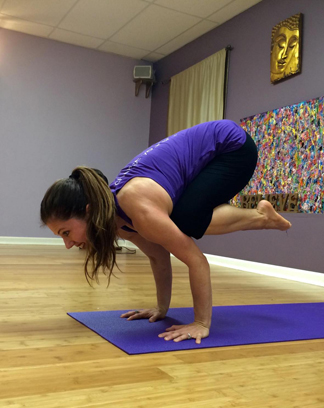October Pose of the month

Bakasana
By: Johanna Toth
Crow pose, or bakasana, is the first arm balance that most students learn, and it acts as the foundational pose that many arm balances are based upon. Although “Baka” is more accurately translated from Sanskrit as “crane”, this pose is most often referred to as “crow”. This pose stretches the upper back and groin and tones and strengthens the arms, shoulders, wrists and abdominal muscles and organs. Students may also find that bakasana improves balance, concentration, full body coordination and, eventually tranquility. Bakasana can be tricky to master but can be a fun pose once you get the hang of it! The key to bakasana is two-part.
1. Confidence and self-awareness, along with a mental resolve to let go of your fear of falling forward. Getting over your fear of possibly falling onto your face requires moving slowly with a calm mind. This focused mindset will help you reduce everyday stress and anxiety, leaving you feeling calm and self-assured. Another tip to avoid toppling forward is to maintain a constant gaze 12-20 inches in front of your mat. Try not to look directly down. You may even place a blanket or pillow in front of you until you feel confident with your balance.
2. Upper body and core strength.You may also find it helpful to practice asanas that directly strengthen your upper body and core, such as plank, chaturanga and forearm plank. The more that you can strengthen your core, the more accessible bakasana will be! And remember to breath. Bakasana allows for different levels of practice: beginners can place knees on bent upper arms, lifting only one foot at a time until sufficient strength and awareness is built. Beginners can also place a block under the feet, which will provide all of the physical benefits and will help the student acclimate to the balance shift. More advanced practitioners may straighten their arms, hop from bakasana to chaturanga, hop into bakasana from down dog or transition from bakasana to tripod headstand and then back to bakasana. There are so many options with this pose; making it one that can evolve and truly grow with your practices.
And remember to breath.
Bakasana allows for different levels of practice: beginners can place knees on bent upper arms, lifting
only one foot at a time until sufficient strength and awareness is built. Beginners can also place a block
under the feet, which will provide all of the physical benefits and will help the student acclimate to the
balance shift. More advanced practitioners may straighten their arms, hop from bakasana to chaturanga, hop into bakasana from down dog or transition from bakasana to tripod headstand and then back to bakasana.
There are so many options with this pose; making it one that can evolve and truly grow with your practice.
